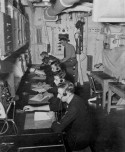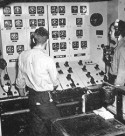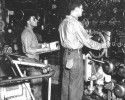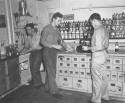ORGANIZATION OF THE USS INDIANA (continued)
Click on any thumbnail for larger view
HULL
 The Hull Department was responsible for the structural integrity and stability of the ship. This included damage response and recovery including counter flooding and also regular routine inspections of the hull, decks and bulkheads of all the decks, compartments and spaces except the engineering spaces. The Hull Department consisted of Boatswains Mates, Ship Fitters, Pattern Makers, and Welders
The Hull Department was responsible for the structural integrity and stability of the ship. This included damage response and recovery including counter flooding and also regular routine inspections of the hull, decks and bulkheads of all the decks, compartments and spaces except the engineering spaces. The Hull Department consisted of Boatswains Mates, Ship Fitters, Pattern Makers, and Welders
R Division (Repair)
 Overview
Overview
R Division was responsible for the general appearance of the ship, maintenance of the ship's hull, it's watertight integrity, fire fighting, counter-flooding to maintain stability, chemical warfare, topside rigging, anchoring and mooring, and catapaulting aircraft.
Duties
R Division personnel were responsible for and manned the Shipfitter Shop, the Carpenter Shop (repaired all wooden parts, decks, furniture, and cabinets), the Paint Locker, the Sail Locker, all of the fire fighting equipment, and the sheet metal repair and welding. The numbering and classification of all valves, fittings, hatches, doors, and other openings in the decks, bulkheads, and hull of the ship was an R Division responsiblity. They also tested all compartments by plugging all openings and then built up air pressure for five minutes to find any leaks.
At General Quarters the R Division personnel manned (along with the EX Division) the Repair Parties, where they were available to contain damage to the ship, fight fires, decontaminate chemical affected areas, man counter-flooding valves, etc. R Division were the fireman aboard ship with the help of the deck divisions
Watch standing assignments were in Damage Control Center and at the various Repair Party patrol stations. Primary watch function was to assure the proper maintenance of the ship's watertight integrity.
COMMUNICATION
 The Communication Department was responsible for all communications between the ship and the rest of the world. This included written, visual signals, and wireless transmittions. The Communications Department consisted of Radiomen, Radio Technicians, Signalmen, and Yeomen assigned to three divisions:
The Communication Department was responsible for all communications between the ship and the rest of the world. This included written, visual signals, and wireless transmittions. The Communications Department consisted of Radiomen, Radio Technicians, Signalmen, and Yeomen assigned to three divisions:
CR Division (Radio)
 Overview
Overview
CR Division was responsible for the encoding, sending, receiving, and decoding of the wireless communications.
CS Division (Signal)
 Overview
Overview
CS Division was responsible for sending and receiving of visual signals, semaphore and light during daylight hours and light during darkness.
Complement
The Division complement based on the watch, quarter, and station bill was 47 officers and enlisted men. Four or five officers and the remainder enlisted. Murl John Lucas remembers that the division was never up to complement. The enlisted consisted of one Chief, two first class, five or six second class, seven or eight third class and the remainder were nonrated S1c, S2c,and AS.
Organization and Duties
The division was divided into five sections each supervised by a second class and each consisted of about seven men including one or more of the third class. This section grouping allowed the division to give a section the mid-watch each fifth day. Darkened ship provided evening, mid and morning watches (dusk to dawn) that were primarily lookout duties at sea. During daylight hours (morning GQ to dusk GQ) two sections were on watch on each side of the bridge, each supervised by its second class PO, with the third class available for sending and receiving flashing light, reading and calling flag hoists etc. Each of the flag bags was supervised by a third class or senior S1c. The Chief and two first class stood the day duty (morning GQ to dusk GQ), with two on watch at all times during the daylight hours. Both first class PO's slept in bunks on the port and starboard wing of the bridge, rather than in the berthing compartment in the forecastle. Additional duties included on-the-job training, normal ships work, signal flag repair and making inspections as necessary for signal halyard rigging maintenance and repair
Equipment
Equipment provided to support the visual communications function included four-12inch signal searchlights (bulb reflecting type), two-24inch carbon arc signal searchlights for long range signaling. At the rear of the bridge on each side were two flag bags (total of four) each with two complete sets of signal flags etc. Also mounted at the rear of the bridge (each side) was a telegraph key connected to blinker lights on the yardarm.
Each of the bags held 26 alphabet flags, 10 numeral flags, 10 numerical pennants and a set of special flags i.e., speed, course, turn, emergency, four repeater pennants 1, 2, 3, 4, attach line used to separate two different signals on the same halyard, plus flags to designate organizational units, section, divisions, squadrons, flotillas etc. Each ship had a "what the hell pennant" if something was completely snafu. Each side of the ship had six halyards attached to the yardarm. The downhauls were 1inch manila and the rest of halyard was woven flax spliced with the manila with the snaps spliced into the bitter end of the flax. The downhauls attached to a rail on the bag where flags had a ring to attach to the last flag on the hoist. The Indiana's signal flags were size three. Destroyers etc had smaller dimension flags
Other Uses Of Flags
Naval flags and pennants have multiple uses. Baker indicates a dangerous operation (refueling, ammo loading, etc). How indicates a pilot aboard. Queen indicates quarantine. The Speed pennant at the port yardarm indicates crew at mess (in port). The first three repeater pennants indicate absence of officers. First repeater outboard on starboard yardarm indicates the Admiral is absent. Second repeater inboard starboard indicates Chief of Staff is absent. Third repeater outboard port yardarm indicates Captain is absent. The governing flags are prep, item, affirmative, negative andoption. The zero flag at the main truck indicates the ship with the guard duty (including the guardmail). The five flag secured with a light line in a bundle is kept ready constantly on a main truck halyard in case of a breakdown. It is broken by yanking the halyard. Item is used as interrogative when questioning something not understood. Prep is hoisted at 0755 and executed at 0800 (in port) for colors. Many signals are self explanatory, speed, turn, course, emergency, etc. Most
other signals must be interpreted by using the general signal books, and are used for information and administrative purposes.
Other Duties
At sea the signal bridge was also responsible for assisting in locating and identifying all vessels in the task unit, and in port notifying the OD of the movements of all ships.
CS Division portion written by Robert Head Stevenson who came on board 30 April 1942 as an Apprentice Seaman and left on 01 November 1945 as a Signalman First Class
Assisted by Murl John Lucas who came on board 30 April 1942 as a Signalman Second Class and left on 03 October 1945 as Chief Signalman
Both were Plank Owners
CY Division (Yeoman)
 Overview
Overview
CY Division was responsible for the written communications and was composed of Yeomen and Yeomen Strikers primarily assigned to the Captains Office and the Executive Officers Office.
Main Duties
Their main duties were: Prepare written correspondence for both officers; Maintain all files; Captain's office maintained officer service jackets and prepared office receipt and transfer orders, kept a calendar of Captain's social events and arranged social calls for all junior officers as they reported for duty; Ensure that all message boards were kept current; Executive office maintained enlisted service records, prepared
monthly muster lists, prepared enlisted transfer and receipt doers, prepared the Plan of the Day, maintained and issued enlisted liberty cards.
Yeomen were pretty well known by ALL HANDS as they had contact with all personnel in some capacity. Particularly because they had control of the liberty cards and eveyone knows how important liberty is to all
sailors - no liberty card - no liberty.
CY Division portion was written by John Richard Urquhart, Jr. who came on board 30 April 1942 as a Seaman 1st Class and left on 28 April 1943 as a Yeoman 2nd Class. He was a Plank Owner. He remained in the Navy after WW II and retired on 01 December 1970 as a Lieutenant Commander.
ENGINEERING
 The Engineering Department was responsible for the operation, storage and distribution of the fuel, water, steam, electrical, propulsion, and auxiliary systems including the repair, maintenance, and replacement of all propulsion machinery, boilers, turbines, generators, motors, evaporators, refrigeration and air conditioning. The Engineering Department consisted of Mechanical Engineers, Electricians, Machinists Mates, Water Tenders, Boiler Makers, and Motor Machinist Mates assigned to four
divisions:
The Engineering Department was responsible for the operation, storage and distribution of the fuel, water, steam, electrical, propulsion, and auxiliary systems including the repair, maintenance, and replacement of all propulsion machinery, boilers, turbines, generators, motors, evaporators, refrigeration and air conditioning. The Engineering Department consisted of Mechanical Engineers, Electricians, Machinists Mates, Water Tenders, Boiler Makers, and Motor Machinist Mates assigned to four
divisions:
A Division (Auxiliary)
 Overview
Overview
A Division was responsible for the operation, maintenance, repair and replacement of the auxiliary machinery systems. They operated and staffed the Log Room (Engineering Office), the Tool Room (Tools for all engine spaces), and the Machine Shop. They were responsible for any machinery, from stem to stern, that other engineering divisions were not responsible for. This included the anchor windlass, shaft alleys, stand-by emergency diesel engines, evaporators (which turned sea water into fresh water), heating and air-conditioning, ice machines, drinking fountains, and refrigerated storage rooms.
E Division (Electrical)
 Overview
Overview
E Division was responsible for the generation and distribution of the electrical system including the operation, maintenance, repair, and replacement of generators, motors and
ancillary electrical equipment.
E Division was divided into four operating groups; Generation and Distribution Group, Special Circuits Group, Motor and Generator Repair Group, General Service and Maintenance Group.
Generation and Distribution Group
This group was responsible for the generation and distribution of all electrical power on the ship. The ship had seven 1,000 kw turbo generators and two 200 kw emergency diesel generators. The emergency diesel generators would phase in when a turbo generator went out. Three of the seven turbo generators ran at all times to supply power for normal operating conditions. If General Quarters was sounded more generators were immediately put on line for the extra power needed for the gun turrets and mounts. Under normal operating conditions the use of the seven generators were rotated to balance out their used hours. Each of the four engine spaces had a distribution board to control the operation of the generators and the distribution of the power to the ship.
Special Circuits Group
This group maintained and repaired special electrical circuits including the telephone system, navigation indicators, ship direction and speed, and salinity cells.
Motor and Generator Repair Group
This group repaired and rewound motors and generators.
General Service and Repair Group
This group maintained, repaired, and replaced damaged control circuits and switches including light bulb replacement.
PA Division (Propulsion Aft)
 Overview
Overview
PA & PF Divisions were responsible for the operation, maintenance, repair, and replacement of the fuel, water, steam, and propulsion systems. This included the boilers,
turbines, reduction gears and propulsion machinery.
Operations
Steam came from the eight Babcock & Wilcox three drum express type oil-fired boilers fitted with two furnaces and double uptakes. Two of the boilers were in each of the four engine spaces. The steam then passed through the throttles, when open, into the high pressure turbine, a very small unit only about four feet across. The steam was at five hundred and seventy-five pounds psi and eight hundred and fifty degrees F. That little turbine developed over sixteen thousand horsepower. Exhaust steam from the high pressure turbine entered the low pressure turbine, a much larger machine, that produced another sixteen thousand horsepower. The steam was then returned to the boilers through the condensers where it became water again. The four engine spaces combined produced one hundred thirty thousand
horsepower. Each of the four engine spaces drove one of the four propellers. PA Division was responsible for the two aft engine spaces
PF Division (Propulsion Forward)
 Overview
Overview
PF Division was responsible for the two forward engine spaces.
MEDICAL
 The Medical Department was responsible for the medical well being of all members of the crew. They attended to the medical and dental needs of ship personnel whether required in normal operation, emergency, or combat operations. The Medical Department consisted of Medical Doctors, Dentists, Pharmacists, and Hospital Apprentices and had one division.
The Medical Department was responsible for the medical well being of all members of the crew. They attended to the medical and dental needs of ship personnel whether required in normal operation, emergency, or combat operations. The Medical Department consisted of Medical Doctors, Dentists, Pharmacists, and Hospital Apprentices and had one division.
H Division (Hospital)
 Overview
Overview
Morning sick call was part of the plan of the day and sick bay facilities included a fully equipped operating room, a pharmacy, and a dental office with x-ray facilities and two(2) modern dental chairs.
Duties
At the call to general quarters all officers and all enlisted men of the division moved quickly to their designated battle stations which were situated strategically throughout the ship where medical lockers and stretchers were located. These medical battle stations were manned by a doctor or a dentist and one or more corpsmen, else by a lone corpsman.
The ship normally carried two (2) Kingfisher seaplanes and a lone corpsman was detailed to accompany the crew of the aircraft recovery boat each time it was launched in connection with seaplane recovery from either observation or rescue duty.
A number of "H" division personnel volunteered for landding force duty and were a part of the BB-58 group when task force TF-31 was assembled to make up the initial landing and occupation force into Tokyo Bay. The USS Wantuck (APD-125) came alongside on August 20, 1945 and the TF-31 group transferred from BB-58 via breeches buoy. The Indiana group was then transferred to USS Monitor (LSV-05) on August 21st, and finally onto the beach via the Monitor's landing craft at Yokosuka Navy Base on August 30th. After the official treaty ceremony accepting Japanese surrender was smoothly concluded aboard the USS Missouri BB-63 on September 02, the BB-58 group of TF-31 returned aboard ship on September 05. In reality this return was accomplished via climbing a cargo net thrown over the side at the quarterdeck where all returning personnel stripped fully down and were subjected to an on the spot de-lousing treatment courtesy of "H" division.
SUPPLY
 The Supply Department was responsible for the General Stores Keeping including all of the storerooms; the storage, preparation and disposable of perishable goods; operation and maintenance of the galley and bakery, preparation and serving of meals; operation of the ships stores & services; operation and maintenance of the officers mess and wardroom; and the disbursements of funds. The Supply Department consisted of Store Keepers, Cooks, Bakers, Disbursement Specialists, Cobblers, Tailors, Barbers, Officers Cooks and Mess Attendants assigned to five sections:
The Supply Department was responsible for the General Stores Keeping including all of the storerooms; the storage, preparation and disposable of perishable goods; operation and maintenance of the galley and bakery, preparation and serving of meals; operation of the ships stores & services; operation and maintenance of the officers mess and wardroom; and the disbursements of funds. The Supply Department consisted of Store Keepers, Cooks, Bakers, Disbursement Specialists, Cobblers, Tailors, Barbers, Officers Cooks and Mess Attendants assigned to five sections:
General Stores Keeping Section
Overview
The General Stores Keeping Section included all the maintenance storerooms of which there were at least five different types of material. The Supply Officer ordered all supplies and issued pay vouchers to direct suppliers for materials. Requisitions were issued to supply ships for the more routine supplies.
Commissary Section
 Overview
Overview
The Commissary Section stored and prepared perishabled goods, operated and maintained the galley and the bakery, prepared and served the meals. An inventory was maintained of all food and food supplies. A book record and inventory was posted daily by item.
Payroll Section
Overview
The Payroll & Disbursing Section handled all aspects of the payroll for all enlisted personnel.
SS Section (Ships Stores & Service)
 Overview
Overview
The Ship's Stores & Service Section operated the service stores on the ship including the laundry, uniforms and other clothing sales to enlisted men, tailor shop, barber shop, cobbler, "gedunk" soda fountain, and "pogey bait" store.
SO Section (Officers Mess)
 Overview
Overview
The Officers Mess Section consited of Officers Stewards, and Officers Cooks and were responsible for the housekeeping duties to maintain Officers Country and also included the preparation and serving of meals in the Officers Wardroom.
S Division portion written by Billy Lyle Miller who came on board 30 April 1942 as a Seaman Second Class and left on 09 November 1945 as a Store Keeper First Class. He was a Plank Owner.
CHAPLAIN CORPS
 The Chaplain Corps was responsible for the spiritual well being, and morale of the crew. They conducted normal Sunday and holiday religious services, including burials at sea.
The Chaplain Corps was responsible for the spiritual well being, and morale of the crew. They conducted normal Sunday and holiday religious services, including burials at sea.
Other Religious Services
 Jewish and Mormon religious services were also held in addition to the regular Protestant and Roman Catholic Services.
Jewish and Mormon religious services were also held in addition to the regular Protestant and Roman Catholic Services.
OFFICER COMPLEMENT
The officer complement of the Indiana was:
TYPE |
AUTHORIZED |
ON BOARD
01 SEPT 1944 |
ON BOARD
01 MAY 1945 |
| Captain |
1 |
1 |
1 |
| Commander |
7 |
5 |
5 |
| Lieut. Commander |
8 |
6 |
6 |
| Lieutenant |
16 |
27 |
25 |
| Lieutenant (jg) |
17 |
24 |
37 |
| Ensign |
41 |
36 |
28 |
| Warrant |
14 |
14 |
14 |
| Marines |
3 |
3 |
3 |
| Total |
106 |
116 |
119 |
SOURCES:
- Benjamin M. Givens, Jr.
- World War II Diary
- Unpublished
- Vienna, VA, 1988
- Ship's Log, USS Indiana (BB-58)
- US Archives
- Washington, DC
- USS Indiana Cruise Book
- San Francisco,CA, 1945
Last Updated 30 September July 2001

All the world's a stage
Click on any [Item] below to go to that page
[Return to BB-58 Home Port Page]
[Dedication]
[Short History]
[History of USS Indiana]
[Launching of USS Indiana]
[Commissioning of USS Indiana]
[Ship Photos]
[Crew Photos]
[Shipboard Life Photos]
[Programs]
[Collision]
[Remembrances]
[Yokosuka Landing]
[Organization]
[Specifications]
[Operated With]
[Plank Owners]
[Captains]
[Department Heads]
[Ship's Log]
[Ship's Company]
[Operating Procedures]
[Sources]
[Data Base]
[Reunion Association]
[In Memoriam]
[E-Mail Addresses]
[Map of Pearl Harbor]
[Relics and Artifacts]
[Glossary]
[Favorite Links]
[Web Site Content]

© 1998-2004 Benjamin M. Givens, Jr.

 Overview
Overview
 The Hull Department was responsible for the structural integrity and stability of the ship. This included damage response and recovery including counter flooding and also regular routine inspections of the hull, decks and bulkheads of all the decks, compartments and spaces except the engineering spaces. The Hull Department consisted of Boatswains Mates, Ship Fitters, Pattern Makers, and Welders
The Hull Department was responsible for the structural integrity and stability of the ship. This included damage response and recovery including counter flooding and also regular routine inspections of the hull, decks and bulkheads of all the decks, compartments and spaces except the engineering spaces. The Hull Department consisted of Boatswains Mates, Ship Fitters, Pattern Makers, and Welders
 The Communication Department was responsible for all communications between the ship and the rest of the world. This included written, visual signals, and wireless transmittions. The Communications Department consisted of Radiomen, Radio Technicians, Signalmen, and Yeomen assigned to three divisions:
The Communication Department was responsible for all communications between the ship and the rest of the world. This included written, visual signals, and wireless transmittions. The Communications Department consisted of Radiomen, Radio Technicians, Signalmen, and Yeomen assigned to three divisions:



 The Engineering Department was responsible for the operation, storage and distribution of the fuel, water, steam, electrical, propulsion, and auxiliary systems including the repair, maintenance, and replacement of all propulsion machinery, boilers, turbines, generators, motors, evaporators, refrigeration and air conditioning. The Engineering Department consisted of Mechanical Engineers, Electricians, Machinists Mates, Water Tenders, Boiler Makers, and Motor Machinist Mates assigned to four
divisions:
The Engineering Department was responsible for the operation, storage and distribution of the fuel, water, steam, electrical, propulsion, and auxiliary systems including the repair, maintenance, and replacement of all propulsion machinery, boilers, turbines, generators, motors, evaporators, refrigeration and air conditioning. The Engineering Department consisted of Mechanical Engineers, Electricians, Machinists Mates, Water Tenders, Boiler Makers, and Motor Machinist Mates assigned to four
divisions:




 The Medical Department was responsible for the medical well being of all members of the crew. They attended to the medical and dental needs of ship personnel whether required in normal operation, emergency, or combat operations. The Medical Department consisted of Medical Doctors, Dentists, Pharmacists, and Hospital Apprentices and had one division.
The Medical Department was responsible for the medical well being of all members of the crew. They attended to the medical and dental needs of ship personnel whether required in normal operation, emergency, or combat operations. The Medical Department consisted of Medical Doctors, Dentists, Pharmacists, and Hospital Apprentices and had one division.

 The Supply Department was responsible for the General Stores Keeping including all of the storerooms; the storage, preparation and disposable of perishable goods; operation and maintenance of the galley and bakery, preparation and serving of meals; operation of the ships stores & services; operation and maintenance of the officers mess and wardroom; and the disbursements of funds. The Supply Department consisted of Store Keepers, Cooks, Bakers, Disbursement Specialists, Cobblers, Tailors, Barbers, Officers Cooks and Mess Attendants assigned to five sections:
The Supply Department was responsible for the General Stores Keeping including all of the storerooms; the storage, preparation and disposable of perishable goods; operation and maintenance of the galley and bakery, preparation and serving of meals; operation of the ships stores & services; operation and maintenance of the officers mess and wardroom; and the disbursements of funds. The Supply Department consisted of Store Keepers, Cooks, Bakers, Disbursement Specialists, Cobblers, Tailors, Barbers, Officers Cooks and Mess Attendants assigned to five sections:



 The Chaplain Corps was responsible for the spiritual well being, and morale of the crew. They conducted normal Sunday and holiday religious services, including burials at sea.
The Chaplain Corps was responsible for the spiritual well being, and morale of the crew. They conducted normal Sunday and holiday religious services, including burials at sea.


